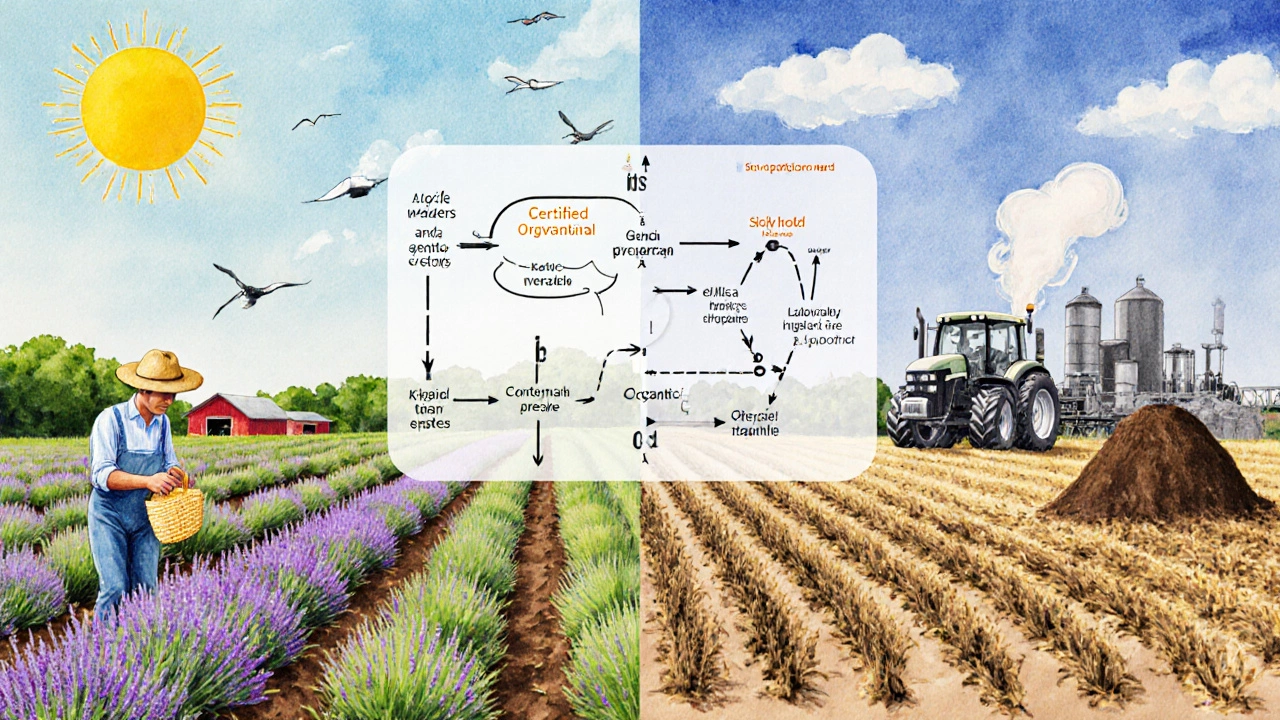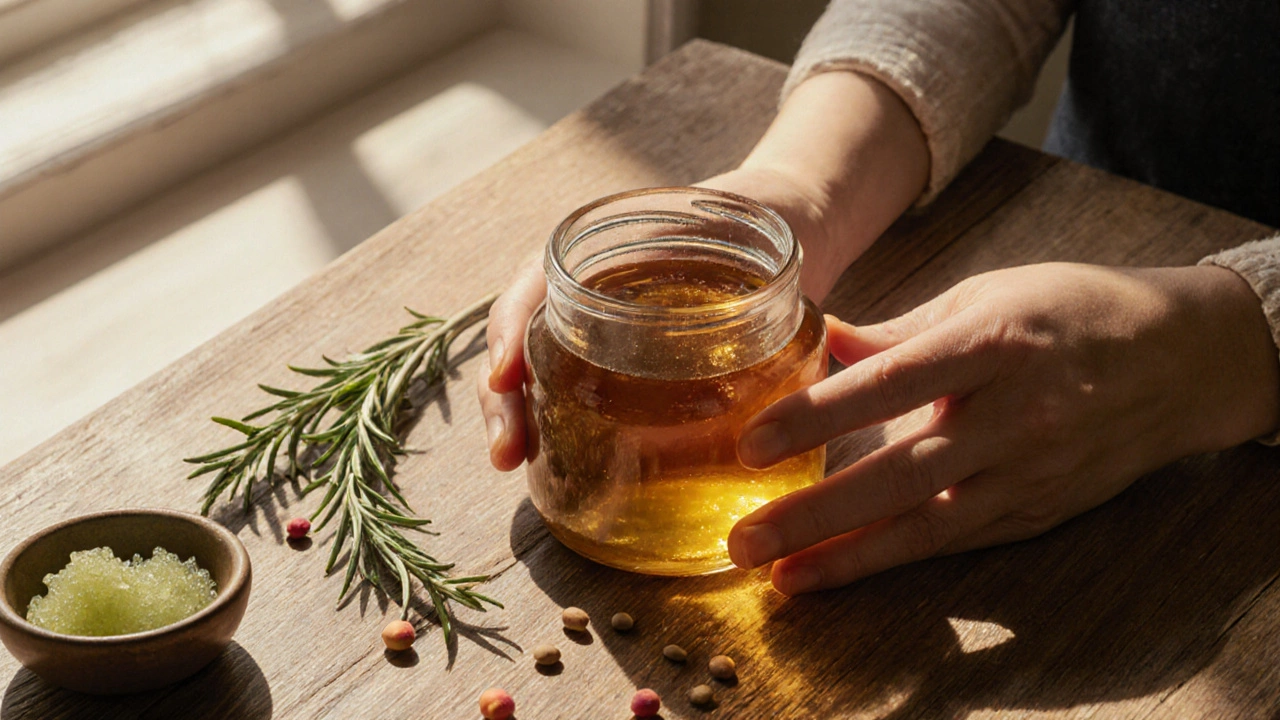Organic Certification Checker
Check Your Product's Claim
Verify if your skincare product meets organic certification standards based on its claimed organic percentage.
When you spot Organic skincare products that claim to follow strict organic‑certification rules, the bottle often shouts "100% natural". But does "organic" actually guarantee that every ingredient is natural? Let’s break down the truth, so you can read labels with confidence.
Key Takeaways
- Organic means the product meets a certified set of farming and processing standards, not that every component is 100% natural.
- Natural ingredients can still be synthetically processed, and some "natural" compounds may be harmful.
- Look for certified logos (USDA Organic, COSMOS, ECOCERT) and read the ingredient list to verify claims.
- Beware of marketing terms like "green" or "clean" - they are not regulated.
- Combine certified organic products with a clear understanding of what each ingredient actually does for your skin.
What Does "Organic" Really Mean?
In the world of skin‑care, "organic" is a regulated term that refers to how the raw materials were grown and processed. Certifications such as USDA Organic, COSMOS (used in the EU) and ECOCERT set the rules. The main points are:
- Plants must be cultivated without synthetic pesticides, herbicides, or genetically modified seeds.
- Soil health is protected through crop rotation, compost, and reduced tillage.
- During processing, only a limited set of non‑organic additives (e.g., certain mineral salts) are allowed, and they must be listed on the label.
These standards focus on the agricultural stage, not on how the final formula is blended. That’s why an organic skincare cream can still contain a small percentage of non‑organic ingredients like starch‑based thickeners or synthetic preservatives, as long as the total organic content meets the certification threshold (often 95% for “organic” and 100% for “100% organic”).
Natural vs. Organic: Core Differences
The word "natural" sounds harmless, but it isn’t regulated in cosmetics. A product can be 100% natural yet include ingredients extracted with harsh chemicals, or it can contain natural compounds that are known irritants (think citrus oils). Below is a quick side‑by‑side look.
| Aspect | Organic | Natural |
|---|---|---|
| Regulation | Certified by USDA, COSMOS, ECOCERT, etc. | No legal definition; relies on brand claims. |
| Farming Practices | No synthetic pesticides, GMOs, or sewage sludge. | May use conventional farming methods. |
| Allowed Additives | Limited, must be on approved list (e.g., certain acids, mineral salts). | Unlimited; any ingredient derived from nature can be used. |
| Processing | Strict limits on chemical processing; preference for cold‑pressing. | May involve solvent extraction, high‑heat refining. |
| Label Claim | Must display certification logo and percent‑organic content. | Often just the word "natural" or a green design. |

Common Misconceptions About the "100% Natural" Label
Many shoppers assume that if a product says "100% natural" it’s automatically safe for all skin types. That’s not true for two reasons:
- Natural ≠ Non‑irritating: Essential oils like tea tree or bergamot are natural but can cause allergic reactions.
- Processing Can Add Chemicals: Even a natural ingredient can be extracted with solvents like hexane, which leaves trace residues.
In contrast, an organic product that meets a 95% threshold still has to disclose any non‑organic additives, making the ingredient list more transparent.
How to Read Labels Like a Pro
When you pick up a jar, follow this quick checklist:
- Check for certified logos. USDA Organic, COSMOS‑Organic, ECOCERT, or Soil Association seals are visual proof that standards were audited.
- Scan the ingredient list. Ingredients appear in descending order by weight. If the first three to five are organic‑certified botanicals, you’re in good shape.
- Watch for prohibited additives. If you see paraben, phenoxyethanol, synthetic fragrance, or petroleum‑derived silicone, the product cannot be fully organic.
- Look for percentage claims. "Made with 95% organic ingredients" means up to 5% non‑organic is allowed; "100% organic" means every ingredient (except water) meets the organic standard.
Remember, the term "natural" can appear anywhere on the package, but it carries no legal weight.
Real‑World Examples
To illustrate the gray area, here are two popular product types:
- Organic facial oil (95% organic): Contains cold‑pressed rosehip seed oil (organic), jojoba oil (organic), and a 3% fraction of vitamin E acetate - a synthetic antioxidant used for stability. The label will read "95% organic" and display an ECOCERT logo.
- "Natural" cleanser: Marketed as "100% natural" with a green leaf logo, but the ingredient list includes sodium lauryl sulfate (derived from coconut oil but chemically refined) and a synthetic fragrance. No certification appears, so the claim is purely marketing.
These examples show why certification matters more than buzzwords.
Tips for Choosing Truly Natural‑Feeling Products
If you want the best of both worlds-organic credibility and a natural sensorial experience-keep these strategies in mind:
- Prioritize products with a certified organic percentage of 95% or higher.
- Avoid generic "natural" claims without supporting logos.
- Read the full ingredient list; look for recognizable botanical names (e.g., Aloe vera leaf juice).
- Check for minimal, approved additives like sodium benzoate (allowed under many organic standards) rather than a cocktail of synthetic preservatives.
- Consider your skin type. Even certified organic ingredients can be comedogenic for acne‑prone skin.
Frequently Asked Questions
Can a product be both organic and natural?
Yes. If a product meets an organic certification and all its ingredients are derived from nature, it qualifies as both. However, “natural” alone isn’t verified, while “organic” is.
What does 95% organic mean on a label?
It means that 95% of the product’s weight (excluding water) comes from certified organic ingredients. The remaining 5% can be limited‑use additives that are still allowed under the organic standard.
Are synthetic fragrances allowed in organic skincare?
No. Certified organic standards prohibit synthetic fragrance compounds. If a product lists "fragrance" without specifying a natural source, it cannot carry an organic seal.
Why do some organic products still list ingredients like "sodium benzoate"?
Certain preservatives, such as sodium benzoate, are on the allowed‑additive list for organic cosmetics because they have a low toxicity profile and help keep products safe without compromising the organic content percentage.
Is "green" packaging an indicator of organic content?
No. Green packaging is a marketing design choice and does not reflect any ingredient or certification standards.
Armed with this knowledge, you can now separate the hype from the real organic benefits. The next time you see a sleek bottle promising "100% natural", pause, check the certifications, and read the ingredient list. That’s the quickest route to skin‑care that truly respects both your skin and the planet.
